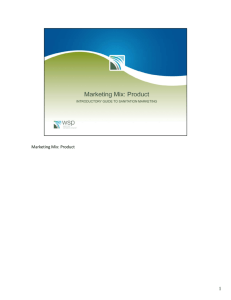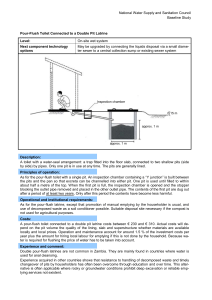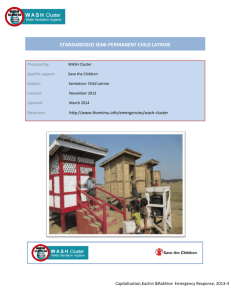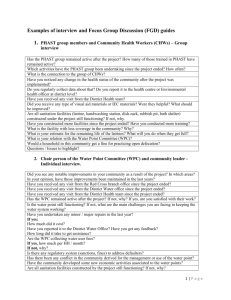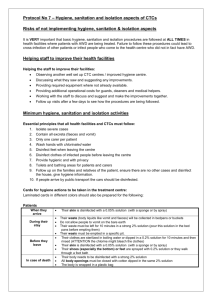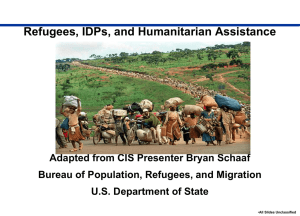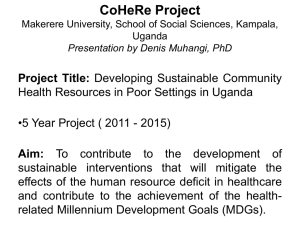standardised semi-permanent adult latrine
advertisement
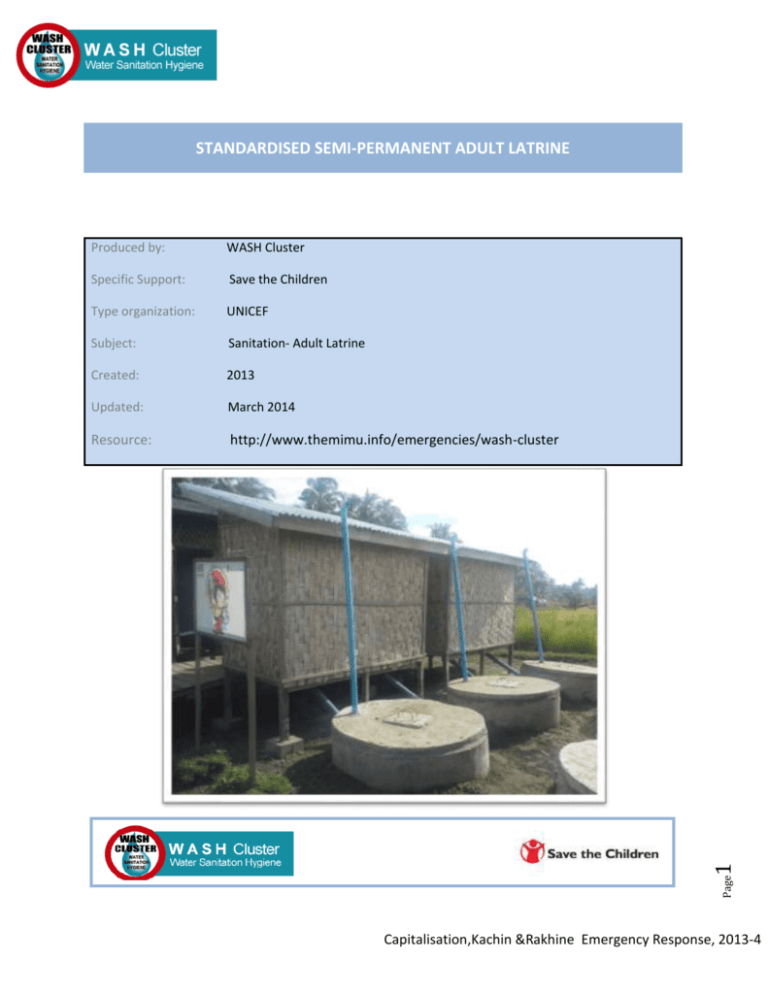
STANDARDISED SEMI-PERMANENT ADULT LATRINE WASH Cluster Specific Support: Save the Children Type organization: UNICEF Subject: Sanitation- Adult Latrine Created: 2013 Updated: March 2014 Resource: http://www.themimu.info/emergencies/wash-cluster Page 1 Produced by: Capitalisation,Kachin &Rakhine Emergency Response, 2013-4 Background The purpose of this document is to formalize the design of adult semi-permanent latrine for both Kachin and Rakhine emergency response while both crises are considered protracted, leading to adapt since mid-2013 the sanitation facilities to provide. This document is also intended to be used as a minimum standard while harmonization of the latrines construction is relevant to ensure a better cost efficiency, acceptance, minimum quality and durability expected. The latrine design proposed is mainly adapted from the locally accepted design across the country. Although there are no significant changes in the design of the superstructure of the latrine, tremendous concern has been raised by humanitarian actors (HA) for the latrine pit design due to the geographical contexts of the location of the IDP camps and the protractile nature of the conflict. The situations in Kachin and Rakhine are not identical; however, the concept of the latrine pit design is equally accepted among the humanitarian actors. After several exchanges between the WASH agencies based on their experiences and findings, the minimum standard and design shared below has been accepted and already implemented since mid2013 as a harmonized approach. This document is subjected to change based on the regular review and inputs from the field situation based on lesson learn.(Preferably every 12 months) Particular characteristics of the Design The primary intended users are the adults. The original design of the adult latrine is developed based on the design from previous natural disaster-related emergency responses, locally available materials, and the acceptability of the local communities as well as the expected duration of the camp status.The main concerns are the density of the IDP population in the camps, the risk of ground water contamination, the constraints related to the desludging and the availability of the resources (both personnel and materials) locally.The double pits septic tanks with concrete rings was identified as themore appropriate to the field situation.Single concrete ring pit is also acceptable in some situations where site is lacking of space. Howeverthat second option is less operational, requesting more frequent desludging of a more liquid sludge and should then avoid when possible. Hence, this document will focus mainly on the double pits type latrine design which can be applied for both Kachin and Rakhine Ongoing Responses. For different type of latrine pit designs, please see the separate document of “Recommended Designs of Flood-resistant Latrine Pits in Rakhine”1. 1 Recommended Designs of Flood-resistant latrine pits in Rakhine produced in 03 March 2013. Page 2 The life-span of the latrine pits is primarily aimed from a minimum of 1 year to a maximum of 5 yearsprovided that the latrine pits are emptied regularly and maintained. Capitalisation,Kachin &Rakhine Emergency Response, 2013-4 Although the context of Kachin is different ingeographical and cultural situations, majority of the concept is replicated by WASH agencies with few adaptations. Table 1 Design of Latrine No. 1. Structure Cabin 2. Walling 3. Door Specifications of Materials Individual vs Block/Set Up to 4 latrines per 1 block/set (4 feet in width, 4 ft in length and 6 ft in height per individual latrine) Not easily penetrable (Bamboo/Zinc/Fabricated Fibre/Wooden), Safety and privacy Lockable Inside 4. Roof 30 Degree Slope , can withstand the wind speed of 40 mph 5. Steps 6. Pit Not slippery, strong and can bear weight of 2 persons with or without hand rails. Single or Double pits (Concrete rings) with or without leach field. Wider concrete ring should be used if the ground water table is higher. One latrine will be connected to only one “solid phase” pit. But the “liquid phase” pits can be connected to two “solid phase” pit to save space and money. Both pits need to be raised at 50cm from the ground to limit flooding First pit is sealed, so will not contaminate ground water. Second pit is not sealed at bottom, so can potentially contaminate ground water, but contains less contamination effluent, limiting contamination. The pits are connected with PVC pipes. A circular concrete slab is installed on the top of each pit, with vent pipe for aeration. According to the space, the second pit can also have also an “overflow” pipe leading to infiltration trench to accelerate the infiltration. 7. Vent pipe Remark The following conditions need to be considered before the construction of the superstructure of the latrines. Weather Land Space Soil type Camp size Aquifer Level Available Materials Impact on environment Community’s preference User Interface Black Colour wide diameter and the height should be 6 incheshigher than the superstructure to facilitate the release of odour and gas. Or iron vent pipe. The inlet of the vent pipe should be closed with mosquito net. Figure 1Four units of Double Pits type semi-permanent Latrine (Front View) Page 3 Perspective of the designof latrine Capitalisation,Kachin &Rakhine Emergency Response, 2013-4 Figure 2 Four units - Double Pits type Semi-permanent Latrine (Top View) Page 4 Figure 3 Four units – Double pits type semi-permanent latrine (Side View) Capitalisation,Kachin &Rakhine Emergency Response, 2013-4 Figure 4 Four units – Double pits type semi-permanent latrine (Isometric View) Guidance notes: All adult latrines should meet the recommended standards from Sanitation Minimum Sphere Standard Package2. Gender separated latrines are available: 1 for 50 people in first emergency (going to 1 for 20 people once situation is stabilized). Latrine and latrine pit are elevated from ground level in flood-prone area (recommended height is 50cm). Latrine have access steps (no more than 7 inches per step), and are lockable from inside. Latrine are used, and open defecation is kept minimum (less than 3 evidences of open defecation during a transect walk across the camp. All full latrines are either emptied safely, or decommissioned according to standard procedure. An initial kit was provided for cleaning and maintaining the public latrine. The minimum kit contents are 1 soap net or box, 1 plastic bucket (15 Litre), 1 cup, 1 brush with handle, 6 pcs of 125 g soap bars, 1 jerry can 20 litres. Each block of latrine should have a hand washing container (maintained full with water), with soap attached. Latrine should be as close as possible from the dwellings (recommended distance is 50m), while staying at 30m from water point, especially if there is soak away pit is included or if there pits are not sealed (infiltration) or if there is an overflow with leaching field. Special consideration should be taken when near to the agricultural area. Latrine maintenance: one person for each 10 latrines is responsible for the maintenance (hourly cleaning, water and soap for hand washing point). In the emergency phase, this person will be paid 3,000MMK/day, working every day. During the early recovery phase, other option involving community participation will have to be chosen. These workers should be rotated frequently (every week or every month). At least 10°% of the male latrine and 10% of the female latrine are disabled-friendly Disabled-friendly latrine Should include the following: - a seat (chair frame with a hole in the middle) and a bar on the wall near the door, to help person sitting - make the latrine door larger, for people with crouches, and make sure door open towards the outside Sanitation Minimum Sphere Standard Package 2012/3 by WASH Cluster, www.themimuinfo/emergencies/washcluster Page 2 5 - make the access step larger horizontally, for easy use with crutches Capitalisation,Kachin &Rakhine Emergency Response, 2013-4 Cost and BOQ of Adult Latrine The BOQ and cost of the adult latrines can vary depending on the situation. However, the minimum calculated cost of 1 block of 4 adult latrines (wooden superstructure and concrete ring double pits type) is around 1000 USD. The cost of the 1 latrine is around 250 USD excluding the cost of the skilled labour. The items listed in the following table are based on the generally accepted design. The Bills of Quantity for the four units of adult Latrine are as follow; Table 2 Bill of Quantity of four units of double pits type semi-permanent latrine Sr. 1 2 3 4 5 6 7 8 9 10 11 12 13 14 15 16 17 18 19 20 21 Materials ( Timber ) 3" x 3" x 120 ft ( Timber ) 4" x 2" x 48 ft (Timber) 3" x 2" x 92 ft (Timber) 3"x1.5" x 260 ft Wooden 2" x 0.5 "x 200 ft Wooden (6"x1"x 188 ft) Floor Concrete ring (ø 5' x 1.5') Concrete ring lid (ø 5' x 3'') Concrete ring (ø 3' x 1.5') Concrete ring lid (ø 3' x 3'') Concrete footing (1' x 1 x 2') Conctete Ladder (3 steps) 3.1/2", 3", 2", 1.1/2"Nail Nail ( for zin sheet ) 7' x 3' ( zinc sheet ) Latrine Pan & Pipe PVC Pipe ø 3" PVC Tee ø 3'' PVC elbow ø 3'' Bamboo mat Hinge, Handle, etc: Total Contingencies 5 % Grand Total Unit Ton Ton Ton Ton Ton Ton nos nos nos nos nos nos viss viss sht pair ft nos nos nos pair Quantity 0.1500 0. 0533 0.0767 0.1625 0.0278 0.1567 15 6 8 2 12 4 3 1 11 4 60 6 2 250 4 Rate(MMK) 300000 300000 300000 300000 300000 300000 20000 10000 8000 5000 3000 9000 3000 3000 5000 5000 900 1200 500 250 1500 Approximated Amount Amt(MMK) Amt(USD) 45000 16000 23000 48750 8333 47000 300000 60000 64000 10000 36000 36000 9000 3000 55000 20000 54000 7200 1000 62500 6000 911783 45589 957372 950000 47 17 24 51 9 49 316 63 67 11 38 38 9 3 58 21 57 8 1 66 6 959 48 1007 1000 Remark Superstructure Superstructure Superstructure Superstructure Superstructure Superstructure Latrine pit Latrine pit Latrine pit Latrine pit Superstructure Superstructure Superstructure Superstructure Superstructure Superstructure Latrine pit Latrine pit Latrine pit Superstructure Superstructure 1USD = 950 MMK Main Findings & Lesson Learned a. Durability of the latrine and its pit Page However, due to the high density of the users and the high water table of the soil, the life span of the pits is significantly shorter than the estimated period (usually about 3-6 months). As a consequence, the designs of the latrine pits were reviewed by all the WASH agencies. Where there is high ground water level, the wider concrete rings can be used to keep the volume of pit as large as possible. The 6 In the initial phase of the emergency, all WASH agencies were mainly focused on temporary latrines (with bamboo lined pits) which were easily collapsedover a six-month period. As a result, some WASH agencies took initiative to construct a more durable type of latrines with wooden lined latrine pits. Capitalisation,Kachin &Rakhine Emergency Response, 2013-4 current concrete ring type of latrine is generally estimated to last about 1 to 5 years. However, the desludging of the latrine is still a major work load and challenge for all WASH agencies as it latrines became full faster than expected. Thus, in late 2013 some agencies implemented temporary stabilization and treatment sitesalong with the various type of transportation. b. Cost effectiveness The cost of the single concrete ring type latrine is around 350 to 400 USD and the single concrete ring type latrines also require more frequent desludging. Whereas, the double concrete ring type latrines is less costly and may last longer. Being identified the cost effectiveness, upgrading of the single concrete pittype latrine to a two-pit latrine isbeing undertaken by some agencies. For example in Ohn Taw Gyi IDP camp. c. Cross cutting issues with other sectors Firewood – Steps and the walls of the latrines were taken by IDPs to use as fuel due to the lack of firewood. Thus, it has resulted in replacing with either concrete blocks or sand. Each solution has its pros and cons. Protection – Women and children are highly reluctant to use the latrines at night time and early in the morning due to the lack of lighting to the latrines. Privacy is still an important issue as the bamboo sheet become rotted with time as well as the users used the parts of the bamboo sheet as a material to do the anal cleaning specially in dry season, when the water availability is a strong concern. Some agencies used the bamboo sheet erected outside the latrine to provide more privacy to the women. Disability – Latrines for disable persons are not available in all the camps and the location of the disable friendly latrines need to be identified together with the IDPs to ensure in keeping the minimum distance where disable persons are residing. Moreover, it is also found that the current design needs improvement in the following parts such as larger door, hand rail and narrow footsteps with wider width are required to create more space and better access both for disable persons and the care takers of the disable person. d. Limitation in Geography and Weather Page The type of the soil has a great impact on the life span of the latrine pits as well as on the contamination of the ground water. The life span of the latrine pits in sandy soil is usually 2 to 4 months longer than the pits in muddy soil where the permeability is considerably low. In addition, the ground 7 The location and availability of the land space is a major factor for WASH agencies where the camps are closely located to the paddy field or the rural dwellings. Thus, the latrine constructions become difficult and sometimes, the minimum standards are hard to achieve. In addition, some WASH agencies and authorities commonly used the decommissioning method (moving the superstructure and dig new pit) in the early phase of the emergency period. Another important fact from the logistical perspective is the access to the pits for desludging which is a great challenge for all WASH agencies. Therefore, it should be contemplated before the construction of the latrines. Capitalisation,Kachin &Rakhine Emergency Response, 2013-4 water table is shallow up to 1.5-2 meters in some areas and as a consequence, the risk of water contamination is considerably increased. Therefore, it is important for the implementing agencies to consider the type of the soil, the level of the water table including the topography and the overall life span of the latrine in designing the latrine pits. Rakhine has a heavy rainfall during the raining season. This has direct and indirect impact on the implementation of the WASH activities and the lifespan of the latrine and its pit. Therefore, the construction work should be distributed after considering the rainfall period. Table 3 Average Rainfall in Rakhine State in 2012 May 268 mm June 1091 mm July 1155 mm August 1025 mm September 537 mm October 289 mm Furthermore, some roofing of the latrines was damaged by the strong wind during the monsoon season. Although these incidents were relatively rare, the risk mitigation should be taken during the construction by adding for example wind breakers. e. User Interface It is found that the IDPs are considerably diverse in terms of social, educational and economic backgrounds. The majority of the IDPs did not have good hygiene. This heterogeneity of the IDPs makes the implemention of activities with an intermediate mobilization ground. Hence, emphasis has been put on to minimize the open defecation practice among the IDP population through the community mobilisation activities. Depending on the discussions with IDPs, the assigment of the latrines were either seggregated by gender or attributed by families. The following concerns such as privacy, lighting, smell and availability of water has been expressed by the IDPs. f. Operation and Maintenance (O&M) In general, the O&M is taken by the implementing WASH agencies by assigning either paid or unpaid volunteer workers to clean the latrines. This should be gradually transferred to the community in order to uplift the ownership sense in the community. For the major repair, WASH agencies usually take the lead which means that the repair cost needs to be considered in the initial budget for every latrine Page 1. The design of the latrine pits should be adapted depending on the camp size, the type of soil, the level of water table including topography, the overall lifespan of the latrine and the density of the IDP population. 2. In the area of high ground water level, wider concrete rings and watersealed concerte rings can be used to keep the volume as large as possible. 3. In the flood prone area, the level of the latrines should be elevated 1 to 1.5 metres above the ground level. 8 Recommendations Capitalisation,Kachin &Rakhine Emergency Response, 2013-4 Page 9 4. Coordination with the local authorities, shelter and other relevant sectors should be taken before the planning of the construction. 5. Approval for Land Use should be obtained before the construction to avoid the unnecessary conflict among the IDPs and communities. 6. Discussions with IDPs or community should be done to define the location of the Gender Separated Latrines to enhance the privacy of women. For example, latrines for women will be constructed on the one side of the camp and latrines for men on the other side of the camp. 7. It should be contemplated before the construction of the latrines for the access of the desludging of the latrines. 8. Desludging, transport and treatment, and decommissioning of the adult latrines should follow the common procedures defined at the WASH cluster level. 9. During the recovery phase, involving community participation will have to be chosen. These workers should be rotated frequently (every week or every month). 10. Emphasises need to be put on to minimise the open defecation practice among the IDP population through the adapted hygiene promotion activities. 11. Installation of the light, access path to latrines should be provided where relevant. 12. Operation and Maintanence of the latrines should be gradually transferred to the community in order to uplift the ownership of the community. 13. Cost of repair should be considered from the design phase Capitalisation,Kachin &Rakhine Emergency Response, 2013-4

